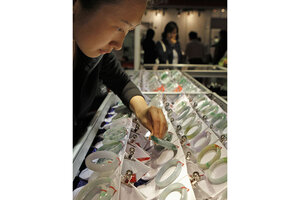Prize, annoyance, memento: The many meanings of my jade bangle

A woman peruses jade bracelets at a jewelry fair in Beijing. In China, jade is a traditional mother-to-daughter gift.
AP/File
Sometimes I forget it’s there, its weight one with my hand now: a solid, seamless piece of pale green stone, smooth and cold. I have worn this jade bangle on my wrist for 20 years.
I can’t take it off.
I was 11 when I got it. Jade bracelets are usually worn by older Chinese women who may or may not believe they provide positive energy and protection from evil spirits. Highly prized in Chinese culture, jade jewelry is commonly given by mothers to daughters. My grandmother had a jade bracelet. My mother has one, given to her by my grandmother on my mother’s wedding day.
Why We Wrote This
The search for one’s identity is universal. For this essayist, a traditional piece of jewelry has been an ever-shifting reflection of how she sees herself.
I remember the day it went on my wrist. We stood over the sink, my grandmother and I. She held my left forearm firmly under the cool running tap at the sink. I began to have second thoughts.
But my grandmother, whom we called Mama in Cantonese, was determined. Her lined square face showed no sign of worry as she tried to push the bangle past the knuckles of my scrunched-up hand. “It will fit,” she said.
We tried using a plastic bag, to reduce the friction of stone on skin. No good. The water didn’t help, either. Inspired, Mama squeezed a dollop of dish detergent onto my wet, plastic-covered hand.
I turned to my mother and aunts, who sat at the kitchen table observing my ordeal with amusement. “I don’t want this anymore,” I said. But right then, Mama let out a triumphant cry. The bangle had slipped past my knuckles and onto my wrist.
I did want it. I’d asked for it, in fact. A sense of finality began to sink in as I rubbed my sore hand. It had taken a good 15 minutes to squeeze my hand into the bracelet. I immediately tried taking it off.
“It is better that it is small,” Mama declared. “Now it won’t come off.”
I grew up in Brunei, away from my paternal grandparents and extended family, who lived in Ipoh, a city about 2 1/2 hours north of Kuala Lumpur, Malaysia. My father is from Ipoh. We would visit on school holidays or for Chinese New Year, but as I grew older, I felt increasingly distant from my dad’s family. For one, we did not speak the same language. My grandparents spoke Cantonese, and I could understand it only somewhat.
My siblings and I were educated in English-speaking schools, and it became our primary language, though we spoke a hodgepodge of Mandarin, Fuzhounese, and English with our non-English speaking parents at home. We grew up on a diet of Western media and literature, though my mom made sure we celebrated every festival on the Chinese calendar.
Perhaps it was this sense of disconnection that made me desire – even as a young girl – something, anything, to make me feel more Chinese.
When I left home to attend university in Australia, visits to Malaysia grew less frequent. I immersed myself in my liberal arts studies. I knew more of Shakespeare than of classical Chinese literature.
The jade bracelet began to feel like an inconvenience. It clashed with my outfits and drew curious looks and questions. Something that was odd for a girl to wear was even odder on a young woman.
The question I disliked most was where I was from: Yes, I’m Malaysian, but I didn’t grow up there. I’m from Brunei, but I’m not Bruneian. I’m Chinese, but not from China. I pondered ways to remove the bracelet – even as I pondered my identity and place in the world.
When my grandparents passed away, I felt regret: I’d never asked them what life was like under the Japanese occupation, or about their childhoods. Why had they left China? Now I’d never know. My jade bangle was a memento of lost opportunity, of a heritage I had not truly embraced.
After graduation, I moved to Malaysia to work – and partly to find what it meant to be Malaysian. I’ve worn the bangle for 20 years now. It has seen me through high school and college, romance and heartbreak, my first job, my wedding – and now a pandemic and a long-distance marriage. I still can’t speak Cantonese well, nor can I take off the jade bracelet. But I no longer want to.
Today when I look at it, I remember my grandparents. I recall the languid, humid holidays of my childhood spent at their house, a house that always smelled of incense.
Now the jade bangle recalls the traditions that help define me – traditions that remind me where I come from.

